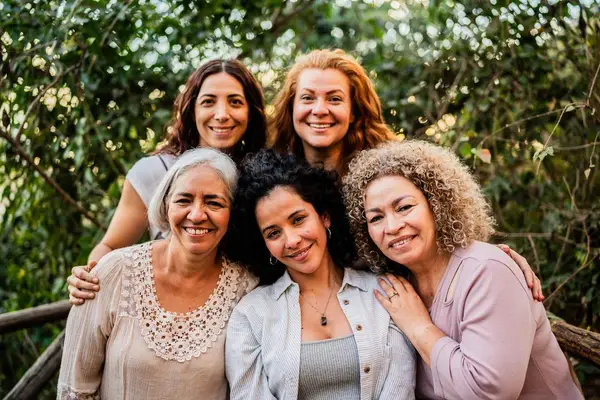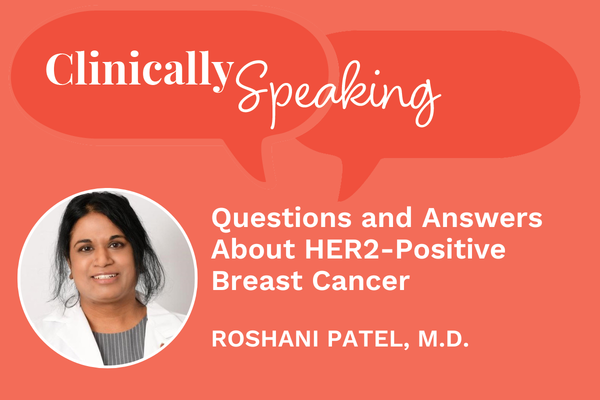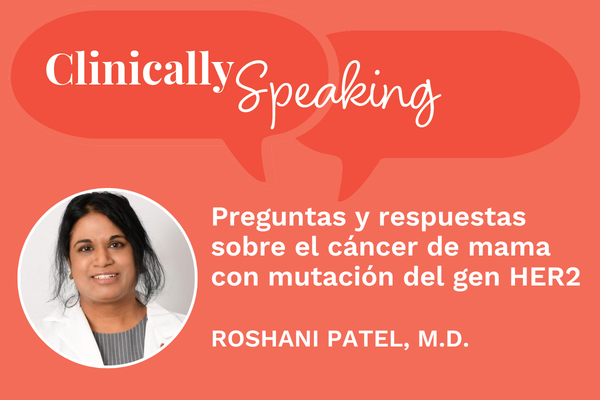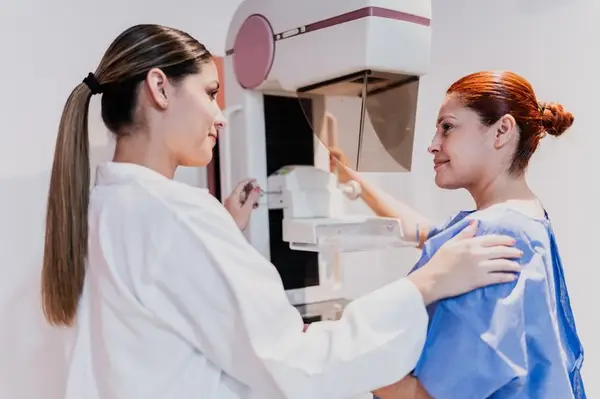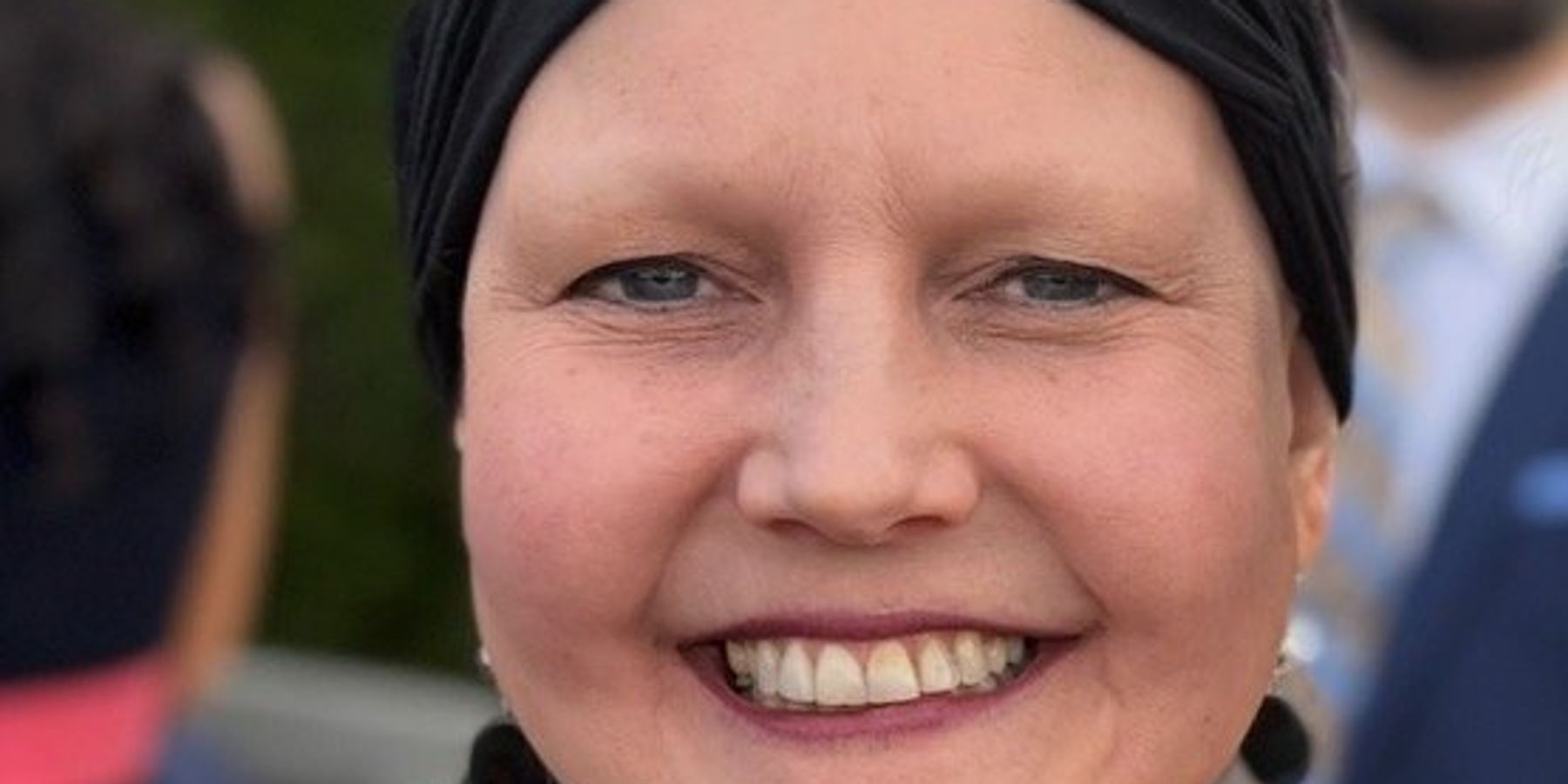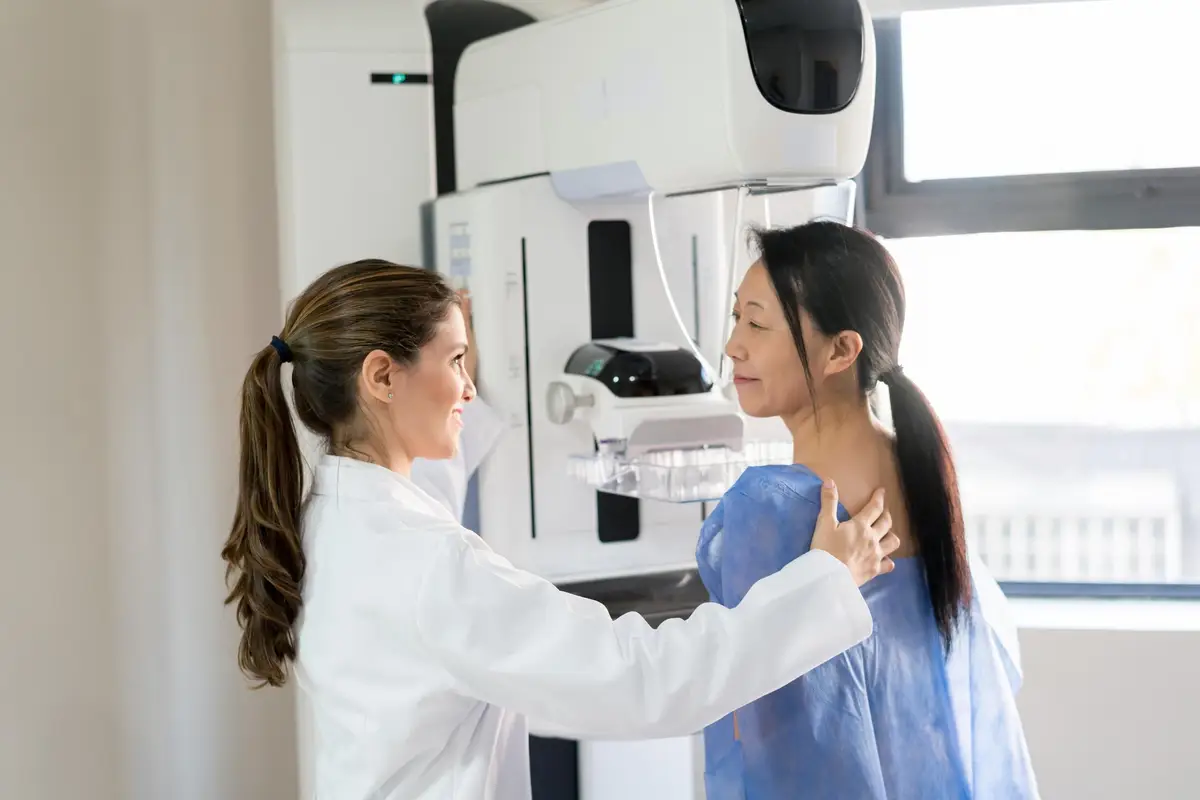
Search powered by AI
Medically Reviewed
Overview
Breast cancers can start in different parts of the breast, with the cells forming a tumor that can often be seen on an X-ray or felt as a lump. This is not always the case, which is why mammograms are recommended to detect cancers at an earlier stage, often before they can be felt, and before symptoms develop.
Guidelines
Along with other medical societies, the American Cancer Society (ACS) has screening guidelines for the early detection of breast cancer. Below is a summary of the recommendations:
- For women at average risk of breast cancer
According to the ACS, a woman is at "average risk" of breast cancer if she does not have a personal or strong family history of breast cancer, a genetic mutation known to increase the risk of breast cancer and has not had chest radiation therapy before age 30. The ACS recommends that:- Women between 40 and 44 have the option to start screening with a mammogram every year.
- Women ages 45 to 54 should get mammograms every year.
- Women 55 and
above
can
switch to a mammogram every other year or continue yearly
mammograms. Screening should continue as long as a woman is in good
health and is expected to live at least 10 more years.
- For women at
high risk for breast cancer
The ACS recommends that women at high risk for breast cancer get a mammogram and breast MRI every year, usually starting at age 30. ACS defines a woman of being at "high risk" if she:- Has a lifetime risk of breast cancer of 20% or greater based on risk assessment tools that estimate risk
- Has a known BRCA gene mutation
- Has a first-degree relative (parent, brother, sister, child) with a BRCA gene mutation
- Has an inherited disorder that increases the risk of developing breast cancer, such as Cowden syndrome
- Had radiation to the chest between the ages of 10 and 30
Screening
Clinical Breast Exams
Often done during your annual medical checkup, a clinical breast exam involves a trained health care professional carefully feeling your breasts, underarm and the area just below your clavicle (breastbone) for any changes or abnormalities. The ACS recommends clinical breast exams at least every three years for all women in their 20s and 30s and annually for women ages 40 and older.
Breast Self-Exams
Regularly examining your own breasts is a useful and important screening tool, especially when used in combination with mammograms and regular exams by your HCP. Many breast cancer organizations recommend that all women perform breast self-exams regularly, and the ACS says they are an option so women can notice changes in their breasts more easily.
Mammograms
Mammograms use low-dose X-rays to find breast cancer. Overall, the sensitivity of mammography is 87%, meaning mammograms correctly identify about 87% of women who have breast cancer. Besides the two-dimensional (2D) mammogram where two X-rays are taken — one from the top and a second from the side — there are now three-dimensional (3D) mammograms, which collect multiple images of the breast from several angles, says they are an option so women can notice changes in their breasts more easily.
Breast Density and Additional Screenings
Nearly half of women aged 40+ who get mammograms have dense breasts, which means their breasts have a lot of glandular tissue and not much fat. Because breast density increases the risk for breast cancer, it is important to ask about breast density at your next mammogram and get a copy of your mammography report, which will include information about the amount of dense breast tissue in your breasts.
If you are diagnosed as having high breast density (more than 50% glandular or fibrous tissue), it is important to know your risk factors for breast cancer and to get a mammogram every year. For women with a lot of dense breast tissue, breast specialists often recommend combining the mammogram with additional screening tests to increase the detection of breast cancer, such as breast MRI.
Risk Factors
Although breast cancer cannot be prevented, there are things you can do to lower your risk. However, there also are risk factors that can't be changed. Some key risk factors are:
- A personal history of breast cancer
A woman with cancer in one breast has a higher risk of developing a new cancer in the other breast or in another part of the same breast. - A family history of breast cancer
Overall, about 15% of women with breast cancer have a family member with the disease. A first-degree relative (mother, sister or daughter) with breast cancer almost doubles a woman's risk. - A reproductive history that raises breast cancer risk
Women who begin their menstrual periods before age 12, don't have children or don't have children before age 30, and/or those who start menopause after age 55 are exposed to hormones longer, raising their risk of getting breast cancer. - A family member with a high-risk gene mutation linked to breast cancer
The most common cause of hereditary breast cancer is inheriting a mutation in the BRCA1 or BRCA2 gene, which normally helps make proteins that repair damaged DNA. Other gene mutations also lead to inherited breast cancers. - Certain benign breast conditions
Some conditions where the cells in the ducts and lobes grow excessively are linked to a higher risk of breast cancer. They include atypical hyperplasia (increased cell production) and a lobular carcinoma in situ, a benign type of breast change visible on a breast biopsy. - Previous treatment using radiation therapy
Radiation therapy to the chest or breasts (like for treatment of Hodgkin's lymphoma) before age 30 increases the risk of getting breast cancer later in life. - Exposure to the drug diethylstilbestrol
There is a slightly increased risk of breast cancer in women given diethylstilbestrol (DES), which was used to prevent miscarriage until the early 1970s. Women whose mothers took DES during pregnancy may also have a slightly higher risk. - Dense breasts Women who have dense breasts on a mammogram have 1½ to 2 times the risk of breast cancer compared to women with average breast density.
There also are risk factors you can change by taking these steps:
- Have no more than one drink of alcohol a day
Studies find a clear link between drinking alcoholic beverages and the increased risk of breast cancer. One standard drink of alcohol (the equivalent of 12 fluid ounces of regular beer, 5 fluid ounces of wine or 1.5 fluid ounces of 80-proof distilled spirits) increases the risk between 7% and 10%, while having two to three drinks a day increases the risk by about 20% compared to non-drinkers. - Eat more nutrient-dense foods
While diet is thought to be partly responsible for about 30% to 40% of all cancers, eating nutrient-rich foods, such as vegetables, fruit, whole grains, beans, nuts, seeds and lean protein, can reduce the risk of breast cancer. - Be physically active
Research shows regular physical activity reduces breast cancer risk, especially after menopause. The American Cancer Society (ACS) recommends 2½ hours to 5 hours of moderate intensity activity a week, such as walking, bicycling, dancing, golf and water aerobics. - Limit your time spent sitting
The ACS has found women who spend six hours or more hours of free time sitting per day have a 10% greater risk of getting cancer compared to women who spend less than three hours of free time sitting per day.
- Maintain a healthy weight after menopause
Having more fat tissue after menopause can raise estrogen levels and increase your chance of getting breast cancer. Also, women who are overweight tend to have higher blood insulin levels, which have been linked to some cancers, including breast cancer. - Understand how hormone replacement therapy affects risk
While estrogen-only hormone therapy appears to lower breast cancer risk, evidence shows that combination hormone therapy increases the risk of breast cancer. Speak to your HCP about your use of hormone therapy and work together to adjust your dose and duration of use as needed.
Other lifestyle-related risk factors for breast cancer include birth control methods that use hormones, not having children and not breastfeeding. If you are at high risk for breast cancer, having a discussion with your breast specialist about these factors can be helpful in deciding about breast cancer screening tests.
Genetic Testing
About 5% to 10% of breast cancer cases are considered "hereditary," meaning the cancer is the result of gene changes passed to the woman from a parent. Of these genes, two of the best known are the BRCA1 and BRCA2 genes. In normal circumstances, these genes help make proteins that repair damaged DNA. However, when a woman inherits a mutated (changed) copy of either gene, she has a higher risk of breast cancer. Another gene linked to the BRCA2 gene called PALB2 also increases breast cancer risk when inherited.
While BRCA1, BRCA2 and PALB2 have received the most attention, other gene mutations also have been identified as leading to inherited breast cancers. This is why genetic testing is now available for almost 100 genes through expanded panel testing, also called multi-gene testing. According to guidelines from the National Comprehensive Cancer Network, genetic testing is recommended for women who have "an increased risk of inherited gene mutation related to breast cancer." This is defined as:
- Having a family member with a BRCA1/2 gene mutation or other high-risk gene mutation linked to breast cancer
- Having a strong family history of breast cancer, especially if the family history also includes certain other cancers, such as ovarian and pancreatic cancer
- Being of Ashkenazi Jewish heritage
The risk of inherited breast cancer is also increased if a family member has had breast cancer. Risk is affected by:
-
The closeness of the
family relationship (a
mother or sister with breast cancer is
more of a concern than a distant relative) - The number of family members who were diagnosed with breast cancer
- The age when the family members were diagnosed
Genetic testing can help women with breast cancer make important decisions, such as whether to get a lumpectomy with radiation or bilateral mastectomy, and to guide those with metastatic breast cancer about treatment with targeted therapies.
However, not every woman needs to be tested, and the pros and cons need to be considered carefully. For this reason, it is helpful to seek the advice of a genetic counselor or breast health specialist who can describe genetic testing to you and explain what the tests may be able to tell you. If you decide to get tested, the genetic counselor (or other health professional) can also help explain what the results mean, both for you and possibly other family members.
Preventive Therapy
Women at high risk for breast cancer have the option of preventive therapy to reduce the estrogen our bodies naturally produce to stop cancer from developing. Called chemoprevention, these medications target estrogen receptor-positive breast cancer, which accounts for almost two-thirds of all breast cancers. The drugs work by attaching to estrogen receptors in breast cells to block the effects of estrogen in breast tissue.
Multiple studies show chemoprevention lowers the risk of breast cancer in postmenopausal women who are at increased risk for the disease. However, these drugs can cause potentially serious side effects, including blood clots to the lungs and legs and endometrial cancers. This is why national cancer organizations and women's health leaders recommend discussing the benefits of chemoprevention with your health care provider based on your individual risk factors.
Preventive Surgery
When actress Angelina Jolie made frontpage news in 2013 by announcing she had a double mastectomy after learning she carried a mutation of the BRCA1 gene, women around the world were introduced to prophylactic mastectomy and its potential in preventing breast cancer. Aimed at removing all breast tissue that could potentially become cancerous, prophylactic mastectomy is elective surgery that removes one or both breasts.
Bilateral prophylactic mastectomy surgery may involve complete removal of both breasts, including the nipples, or it may involve a skin-sparing technique that leaves the nipples intact. This option, called nipple sparing mastectomy, allows for more natural-looking breasts if a woman chooses to have breast reconstruction simultaneously or later. According to the National Cancer Institute, only women who are at a very high risk of breast cancer should consider this surgery. This includes women with one or more of the following risk factors:
- A mutation in the BRCA1 or BRCA2 gene found by genetic testing
- A strong family history of breast cancer, such as breast cancer in several close relatives or in at least one relative at a young age
- Radiation therapy to the chest before age 30
Prophylactic mastectomy is also a consideration when women diagnosed with breast cancer in one breast also have a family history of the disease. The option is to have the other breast removed at the time of surgery to lower the risk of developing a second breast cancer.
Studies show that prophylactic mastectomy may reduce the risk of breast cancer by 95% in women who carry the BRCA1 or BRCA2 gene mutation and lowers the risk of a second cancer by 90% to 95% in women who already have breast cancer. However, prophylactic mastectomy can have surgical complications, such as infection, and can affect a woman's psychological well-being, including difficulties with body appearance. Therefore, it is important to weigh the risks and benefits with your doctor and consider talking to other women who had the operation.
This resource was created with support from Daiichi Sankyo, Merck and Sanofi Genzyme.
References
- American Cancer Society. American Cancer Society Recommendations for the Early Detection of Breast Cancer. Accessible at: https://www.cancer.org/cancer/breast-cancer/screening-tests-and-early-detection/american-cancer-society-recommendations-for-the-early-detection-of-breast-cancer.html.
- UTHealth McGovern Medical School. Breast Cancer Screening Guidelines. Accessible at: https://www.memorialhermann.org/imaging-and-diagnostics/breast-cancer-screening-guidelines/
- Breast Cancer Surveillance Consortium (BCSC). Sensitivity, specificity, and false negative rate for 1,682,504 screening mammography examinations from 2007-2013.
- American Cancer Society. Breast Density and Your Mammogram Report. Accessible at: https://www.cancer.org/cancer/breast-cancer/screening-tests-and-early-detection/mammograms/breast-density-and-your-mammogram-report.html.
- National Cancer Institute. Breast Density: Answers to Commonly Asked Questions. Accessible at: https://www.cancer.gov/types/breast/breast-changes/dense-breasts.
- American Cancer Society. Breast Cancer Risk Factors You Cannot Change. Accessible at: https://www.cancer.org/cancer/breast-cancer/risk-and-prevention/breast-cancer-risk-factors-you-cannot-change.html.
- National Institute on Alcohol Abuse and Alcoholism (NIAAA). What Is a Standard Drink? Accessible at: https://www.niaaa.nih.gov/what-standard-drink#:~:text=In%20the%20United%20States%2C%20one,which%20is%20about%2040%25%20alcohol.
- BreastCancer.Org. Eating Unhealthy Food. Accessible at: https://www.breastcancer.org/risk/factors/unhealthy_food.
- American Heart Association. How Can I Eat More Nutrient-Dense Foods? Accessible at: https://www.heart.org/en/healthy-living/healthy-eating/eat-smart/nutrition-basics/how-can-i-eat-more-nutrient-dense-foods#:~:text=Vegetables%2C%20fruits%2C%20whole%20grains%2C,without%20consuming%20too%20many%20calories.
- U.S. Department of Agriculture (USDA). ChooseMyPlate. Moderate Physical Activities Include. Accessible at: https://www.choosemyplate.gov/resources/physical-activity-what-is.
- American Cancer Society. Sitting Too Much Increases Cancer Risk in Women. July 16, 2015. Accessible at: https://www.cancer.org/latest-news/sitting-too-much-increases-cancer-risk-in-women.html#:~:text=Researchers%20from%20the%20American%20Cancer,free%20time%20sitting%20per%20day.
- American Cancer Society. Breast Cancer Risk Factors You Cannot Change. Accessible at: https://www.cancer.org/cancer/breast-cancer/risk-and-prevention/breast-cancer-risk-factors-you-cannot-change.html.
- BreastCancer.Org. Abnormal PALB2 Gene Increases Breast Cancer Risk More Than Previously Thought. Accessible at: https://www.breastcancer.org/research-news/abnormal-palb2-gene-increases-risk.
- Beard A, et al. NCCN guidelines for genetic testing. Contemporary OB/GYN. July 31, 2019. Accessible at: https://www.contemporaryobgyn.net/breast-cancer/nccn-guidelines-genetic-testing.
- Susan G. Komen. Genetic Counseling and Genetic Testing. Accessible at: https://ww5.komen.org/BreastCancer/GeneMutationsampGeneticTesting.html.
- National Comprehensive Cancer Network (NCCN). Genetic/Familial High-Risk Assessment: Breast and Ovarian. Version 3. 2019; January 18, 2019. Accessible at: https://www2.tri-kobe.org/nccn/guideline/gynecological/english/genetic_familial.pdf.
- American Cancer Society. Genetic Counseling and Testing for Cancer Risk. Accessible at: https://www.cancer.org/cancer/breast-cancer/risk-and-prevention/genetic-testing.html.
- Cleveland Clinic. Medications to Reduce the Risk of Breast Cancer. Accessible at: https://my.clevelandclinic.org/health/drugs/16230-medications-to-reduce-the-risk-of-breast-cancer.
- Susan G. Komen. Tamoxifen and Raloxifene to Reduce Cancer Risk. Accessible at: https://ww5.komen.org/BreastCancer/Table29Theuseof...:~:text=Both%20tamoxifen%20and%20raloxifene%20can,at%20high%20risk%20%5B1%5D.
- American Cancer Society. Preventive Surgery to Reduce Breast Cancer Risk. Accessible at: https://www.cancer.org/cancer/breast-cancer/risk-and-prevention/preventive-surgery-to-reduce-breast-cancer-risk.html.
- WebMD. Breast Cancer and Preventive Mastectomy. Accessible at: https://www.webmd.com/breast-cancer/guide/preventive-mastectomy.
- National Cancer Institute. Surgery to Reduce the Risk of Breast Cancer. Accessible at: https://www.cancer.gov/types/breast/risk-reducing-surgery-fact-sheet.
- Mayo Clinic. Preventive (prophylactic) mastectomy: Surgery to reduce breast cancer risk. Accessible at: https://www.mayoclinic.org/tests-procedures/mastectomy/in-depth/prophylactic-mastectomy/art-20047221.
HealthyWomen content is for informational purposes only. Please consult your healthcare provider for medical advice, diagnosis or treatment.
Related Articles
They Said I’d Only Live 4 Months, but It’s Been 2 Years — and I’m Not Done Yet
Living with metastatic breast cancer has been hard, but I’m thankful for every day
10 Jul 2025
Real Women, Real StoriesDijeron que solo me quedaban 4 meses de vida, pero han pasado 2 años y mi historia no concluye todavía
Vivir con cáncer mamario metastásico ha sido difícil, pero me siento agradecida por cada día que vivo
10 Jul 2025
Real Women, Real StoriesDon’t Count Me Out
I have metastatic breast cancer. But I have goals.
24 Jun 2025
Real Women, Real Stories


